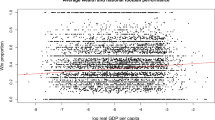Abstract
After 22 seasons of competition, the Arena Football League (AFL) suspended operations in 2009. Play resumed in 2010, but attendance has declined dramatically. We examine the determinants of the demand for tickets to AFL games using data from the league’s first incarnation from 1987 to 2008; we find that the honeymoon effect for first-generation AFL teams was very short. Teams lost about 1,700 fans per game on average in their second year of operation, a sizeable loss given league average of 11,000 fans. Our results also suggest that Major League Baseball (MLB) serves as a direct competitor to the AFL, and this offers insights into why the AFL has struggled in its second incarnation (2010–2012).


Similar content being viewed by others
Notes
Of the 30 NHL teams operating in 2011–2012, only 16 will be competing in a market with an NBA team present within the metropolitan area. It is rare for the NBA and the NHL to compete in smaller markets, and, when this competition does occur, it usually leads to one of the franchises having a difficult time attracting fans. For example, the Florida Panthers and Phoenix Coyotes are commonly cited as franchises that may be forced to relocate. Examples of cities that have been unable to support NBA and NHL franchises are Vancouver, with the Grizzlies (now the Memphis Grizzlies) and the Canucks, and Atlanta, with the Hawks and the Thrashers (relocated to Winnipeg for 2011–2012).
Relatively close proximity means within 100 miles for a “local team” and within a range of 101 to 250 miles for a “regional team”. Gitter and Rhoads view a local team as a team that one could visit for an evening game after work and reasonably return home in the same evening. The regional team is a team that one could visit for a game by making a day trip to the team’s park.
The website http://www.arenafan.com/ has detailed data on the attendance and history of the AFL (Kaufmann 2013).
Accessed at http://www.bea.gov/regional/reis/ (U.S. Department of Commerce 2013).
Models with ln(attendance) as the outcome provide broadly similar results.
This renaming effect is not significant when a team’s tenure in the league is modeled with a quadratic.
References
Chupp, A., Stephenson, E. F., & Taylor, R. (2007). Stadium alcohol availability and baseball attendance: evidence from a natural experiment. International Journal of Sport Finance, 2(2), 36–44.
Clapp, C., & Hakes, J. (2005). How long a honeymoon? The effect of new stadiums on attendance in major league baseball. Journal of Sports Economics, 6(3), 237–263.
Fort, R., & Winfree, J. (2008). Fan substitution and the 2004–05 NHL lockout. Journal of Sports Economics, 9(4), 425–434.
Gifis, L., & Sommers, P. (2006). Promotions and attendance in minor league baseball. Atlantic Economic Journal, 34(4), 513–514.
Gitter, S., & Rhoads, T. (2010). Determinants of minor league baseball attendance. Journal of Sports Economics, 11(6), 614–628.
Kaufmann, J. (Ed.) (2013). Arenafan. http://www.arenafan.com. Accessed June 2013.
Leadley, J., & Zygmont, Z. (2005). When is the honeymoon over? National basketball association attendance 1971–2000. Journal of Sports Economics, 6(2), 203–221.
Manoloff, D. (2008) Arena football league announces it will suspend 2009 season. The New York Times, December 15
McCarthy, J. (2009) AFL’s Future Still in Doubt. ESPN.com, accessed April 6, 2009
Meehan, J., Nelson, R., & Richardson, T. (2007). Competitive balance and game attendance in major league baseball. The Journal of Sports Economics, 8(6), 563–580.
Noll, R. (1974). Attendance and price setting. In R. Noll (Ed.), Government and the Sports Business (pp. 115–158). Washington: The brookings institute.
Stock, J., & Watson, R. (2008). Heteroskedasticity-robust standard errors for fixed effect panel data regression. Econometrica, 76(1), 155–74.
U.S. Department of Commerce (2013). Bureau of Economic Analysis. http://www.bea.gov/regional/reis/. Accessed June 2013.
Winfree, J., McCluskey, J., Mittelhammer, R., & Fort, R. (2004). Location and attendance in major league baseball. Applied Economics, 36, 2117–2124.
Author information
Authors and Affiliations
Corresponding author
Rights and permissions
About this article
Cite this article
Foley, M.C., Smith, F.H. The Rise (and Fall) of the Arena Football League. Atl Econ J 41, 439–450 (2013). https://doi.org/10.1007/s11293-013-9390-2
Published:
Issue Date:
DOI: https://doi.org/10.1007/s11293-013-9390-2



